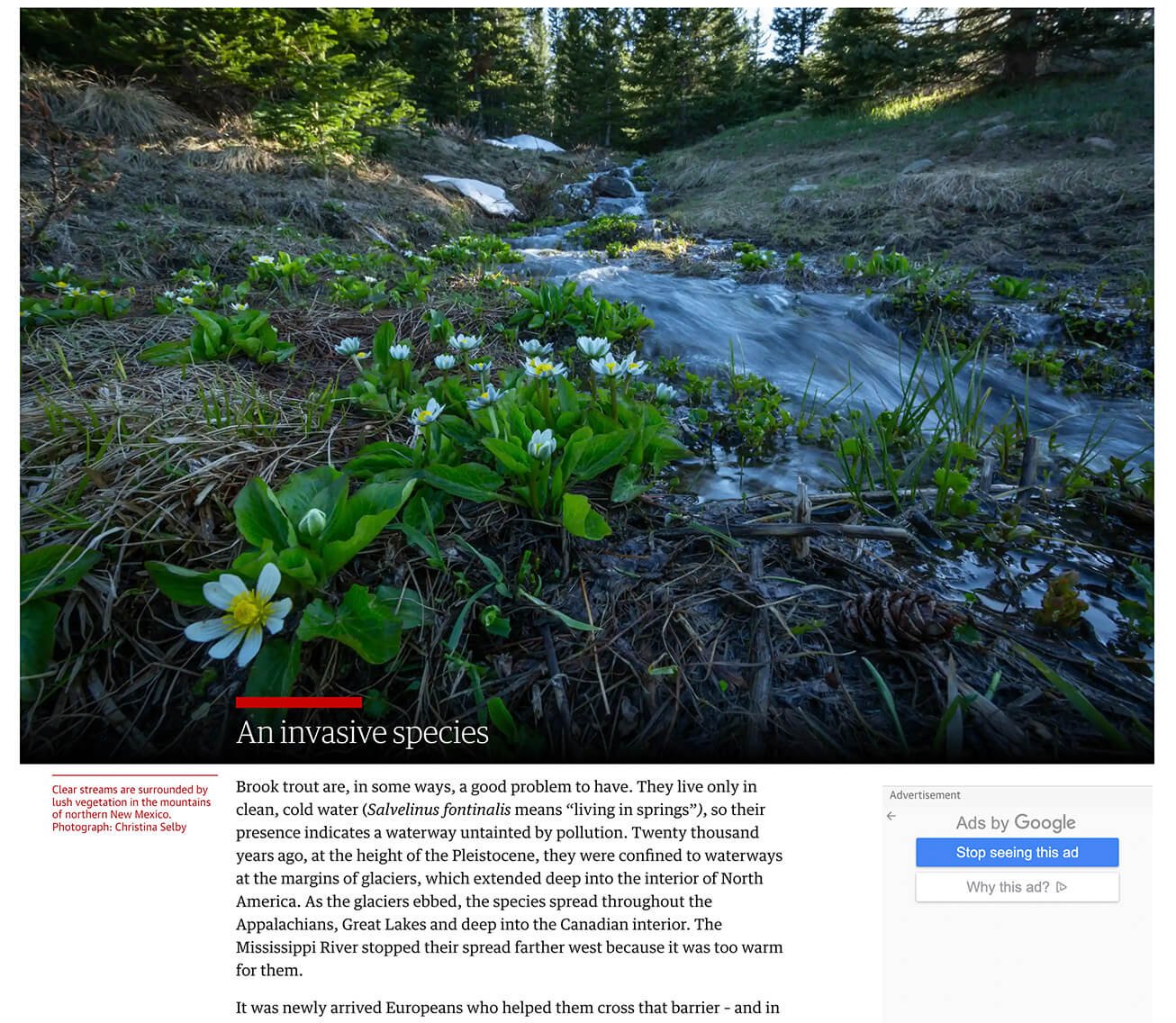Books
TEARSHEETS
CONSERVATION FEATURES: I specialize in conservation storytelling around issues of biodiversity, climate change, deforestation, agriculture and ranching, and endangered places, species, and communities. My work raises awareness of the issues and promotes conservation necessary for positive change and a hopeful future. My long-form articles feature my writing, photography, and videos.
Into Thin Air I Photography assignment I Sierra Magazine I Winter 2023 Issue
Flight of the Cranes (9-page print feature) I New Mexico Magazine I November 2023
The Pinyon Puzzle I Audubon Magazine (print) I Winter 2022
The Intimate Relationship Between Pinyon Jays and Piñon Pines is Unraveling I Audubon Online I December 2022
The Tale of the Trojan Trout I BioGraphic I February 2022
A River's Right to Flow I bioGraphic I October 2021
Into the Wild I bioGraphic I June 2021
Bloom Town I New Mexico Magazine I August 2020
In Search of the Lost I bioGraphic I September 2017
Better Beef I bioGraphic I December 2017
Strategy for Saving Bees I Ensia I February 2015
Line of Descent I High Country News I August 2016
Finding the Flying Monkey I Outdoor Photographer I May 2019
Scientists launch expedition to find missing monkeys I Mongabay I February 2017
Monkey Rediscovered I Mongabay I August 2017
Mysterious Amazon Animal Seen Alive I National Geographic I August 2017
Better Beef I Scientific American I February 2018
Trojan Trout I The Guardian
NATURE/TRAVEL: I write and photograph articles on travel and outdoor experiences in New Mexico and beyond, often but not always, focused on family.
Karst Country I New Mexico Magazine I November 2022
Wildflower Special Issue I New Mexico Magazine I April 2022
Wild Cards I New Mexico Magazine I August 2021
Enchantment Magazine I June 2021
Enchantment Magazine I June 2021
Enchantment Magazine I June 2021
Enchantment Magazine I June 2021
Flower Up I New Mexico Magazine I May 2021
Birding in New Mexico I New Mexico Magazine I April 2021
Step Lightly I New Mexico Magazine I March 2021
Broken Beauty I New Mexico Magazine I May 2020
ADDITIONAL ARTICLES
“Science Photojournalist Morgan Heim Illuminates the Cost of California’s Trespass Marijuana Grows”
Interview with Conservation Photographer Morgan Heim about her Tresspass project.
The Open Notebook, January 8, 2019
"Scientists Launch Expedition to Find Missing Monkey"
Dr. Laura Marsh and her international team of scientists boarded a houseboat and embarked on a four-month expedition in a remote part of the Brazilian Amazon to try to find the lost saki.
Mongabay, February 2, 2017
"Monkey Rediscovered in Brazil after 80 years"
A second report about the Houseboat Amazon expedition team finding the lost monkey. This article focuses on the impact of logging and deforestation in the study area.
Mongabay, August 9, 2017
"Including Diverse Voices in Science Stories"
Science writers use words to draw pictures every day: pictures of biologists, physicists, technology developers, physician-researchers. When science writers draw pictures of science in action, whom do we draw? What is our responsibility to represent the current diversity of scientists and avoid perpetuating stereotypes that, among other things, may contribute to lack of diversity in STEM fields?
The Open Notebook, August 23, 2016
"Trees share carbon: new discovery may be key to saving trees in a warming world"
Ecologists have long understood that trees compete for nutrients and resources. But the results of an experiment in a temperate forest in Switzerland show that interactions between trees may be more complicated than was believed. Trees share resources via underground highways of interconnected fungi and tree roots. These may be the key to trees surviving in a warming world.
Mongabay, August 10, 2016
"William DeBuys Goes to Extremes for Endangered Species"
A Q & A with New Mexico author William DeBuys where we discuss his latest book The Last Unicorn: A Search for One of Earth's Rarest Creatures, traveling with armed men through heavily poached protected areas in Laos, searching for endangered species, and how to defend beauty as a writer.
The Open Notebook, February 9, 2016
Spring Go!: Countering Pokemon with Natural Phenomenon
Convincing my kids to put down the Pokemon cards and get out into nature can be a challenge these days. Inspired by the 2015 book Phenomenal, in which journalist and new mother Leigh Ann Henion sets out to see the world's most spectacular natural phenomena, I decided to try to wow my kids with New Mexico's version.
Tumbleweeds, Spring 2017
"SFR Picks: Adventures Across Time: The incredible true story of one woman's quest for love"
As the warm outdoor season comes to a close into Santa Fe, a performance about an expedition across the steamy Amazon resulting in death, disease and a lone survivor is sure to satisfy anyone’s itch for adventure.
Santa Fe Reporter, print & online, October 12, 2016
"Elizabeth Kolbert Stares Down Mass Extinction"
A Q & A with top notch environmental journalist Elizabeth Kolbert. In her 2015 Pulitzer Prize–winning book The Sixth Extinction: An Unnatural History, Elizabeth Kolbert details the evidence that human activity is causing what scientists call the sixth mass extinction—the loss of as many as half of all living species on Earth. Her follow up article Unnatural Selection in The New Yorker searches for solutions in scientists' radical attempts to save coral reefs and forests from extinction. I spoke with Kolbert about reporting bad news, captivating readers with tales of nature, and turning magazine articles into books.
The Open Notebook, July 26, 2016
"'Mystery cat' requires more conservation and research"
The jaguarundi, a wild cat found from southern Texas to south-central Argentina resembles a house cat but is twice as large with a flat face and rounded ears. Although generally considered the most common cat in the western hemisphere, a new study in the scientific journal Mammal Review finds that biologists and the public know very little about this enigmatic carnivore — and it may be more threatened than expected.
Mongabay, June 10, 2016
How to Be (or Not to Be) an Advocacy Journalist
As the Pulitzer Prize–winning publication ProPublica observes, journalism at its best serves the public and seeks to stimulate positive change. If journalists and advocates share the desire to bring about change, what’s the problem? Why draw a line between the two? And if there’s a line, where is it?
The Open Notebook, May 24, 2016
"Making the Most of a Writers Association Membership"
Whether you are transitioning to a new career, like me, or looking for a new challenge in your current work, how can you get the most out of membership in a writers’ association? It’s crucial to interact with other members—whether online, at local or national meetings, through mentorship programs, or by serving on organizational committees or boards. Writing is a profession in which you learn by doing—and by learning what others are doing.
The Open Notebook, April 19, 2016
"A sex change phenomenon in fish suggests there is something in the water"
Sex is getting complicated. Especially fish sex in New England. Scientists have recently discovered that fish in the northeastern U.S. are changing gender – and it’s not due to an identity crisis. A new study published in Ecotoxicology and Environmental Safety finds that male fish are turning into females – a phenomenon known as intersex – due to chemical pollution, specifically estrogenic endocrine disrupting chemicals or EEDCs.
Mongabay, April 5, 2016
"Writing Elegant Background"
On the craft of science writing. All stories need some explanatory or historical background to tell readers where the story fits into their world. The writer’s challenge is to figure out how much history and context is necessary, where it fits in, and how to write it so it doesn’t slow readers down.
The Open Notebook, March 29, 2016
"The newest strategy for saving bees is really, really old"
With pollinators in decline around the world, conservationists turn to traditional farmers for answers.
Ensia, February 15, 2016
"Pollinators Under Pressure"
Honeybees play an essential role in our agricultural system, but when it comes to native plants, native bees still do the lion’s share of pollinating. Native bees are more efficient and effective at pollinating native plants due to their coevolution with the flowers.
Native Plant Society of New Mexico Newsletter, July, 2015
ESSAYS
"Place Where you Live - Santa Fe, New Mexico"
"I stand in a narrow canyon. Last weekend in this spot I saw an exquisite male Great Horned Owl sleeping in a husky juniper tree. His mate was perched on a cliff ledge above. A petroglyph of a boxy figure with horns rubbed into the chocolate brown rocks above stands guard over the canyon. Perhaps this was the ancient-ones’ way of acknowledging that this place belonged to the horned-ones even then."
Orion Magazine Online, April, 2015
"Deeper In"
"We pulled into a small parking lot off the only road that stretched through the wilderness of South Dakota's Badlands. We had spent the day languidly driving through the park, awestruck by the other-worldly landscape of buttes and bluffs...Only one other car was in the parking lot. It seemed odd to me that so few visitors were in the park in July. Maybe they knew something we didn't."
Lowestoft Chronicle, March, 2015
GUEST BLOGS
"Bees and Butterflies in a Biodiversity Hotspot"
"It is early April and six other Earthwatch volunteers and I are awaiting instructions in an apple orchard in the Kullu Valley, known as the fruit basket of India. Dr. Kumar and Dr. Aman, the lead scientists on this research project, hand out survey sheets. They show us how to record observations of seven types of pollinators to assess their diversity and density. Over time the data will be compiled to document changes in pollinator populations as the climate warms."
Earthwatch Unlocked, May, 2015
"11 Ways to Eat Healthy on a Budget"
How to eat healthy, organic, real food on a budget.
Mother Earth Living Blog, April, 2014
"8 Tips for Easy Gardening"
Maintaining a simple garden is a great way to enjoy the benefits of healthy, fresh food and avoid the impacts of industrial agriculture.
Mother Earth Living Blog, March, 2014
OTHER PUBLICATIONS
"For the Fish: Restoring the Upper Colorado Basin"
"Loud, heavy machinery ripping trees by their roots and excavating sand in the San Juan River’s floodplain is not what you might picture when you think of conservation. Yet, this aggressive restoration strategy is allowing two endangered fish species to recover their populations and a Navajo community to reconnect with the river."
The Nature Conservancy of New Mexico, Annual Report, 2015
"Integrating Culture as a Cornerstone of Success in Sustainability Education"
A compelling case study of sustainability work grounded in cultural democracy, bringing together social justice and environmental sustainability.
Journal for Sustainability Education, March, 2012
"Sustainability Education for All"
From a coffee farming community in Panama to the development of a youth program in New Mexico: How decisions of American consumers can minimize harm to global communities.
Green Money Journal, January, 2009
































